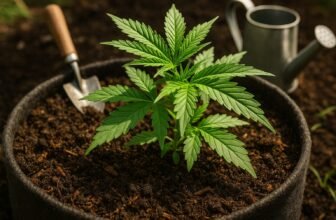
When you’re growing cannabis—whether it’s in a small indoor tent or out in the garden—knowing how to identify female pot plants in the early stage can make or break your harvest. It’s one of the most important steps for any grower, especially if you’re hoping for those rich, seedless buds known as sinsemilla. Unfortunately, too many beginners wait until it’s too late and end up with male plants that release pollen and ruin the entire crop.
Why Early Identification Matters
In the world of cannabis plant sexing, time is critical. If you don’t catch male vs. female cannabis differences early, your female plants may get pollinated—leading to seeded buds with lower potency and reduced yield. Even one male pot plant in your grow space can compromise everything.
By learning to recognize pre-flowers—those tiny structures that appear during the vegetative growth stage—you’ll be able to spot female cannabis signs before the plants enter full bloom. This early insight helps you remove unwanted males quickly and lets your female plants thrive without interference.
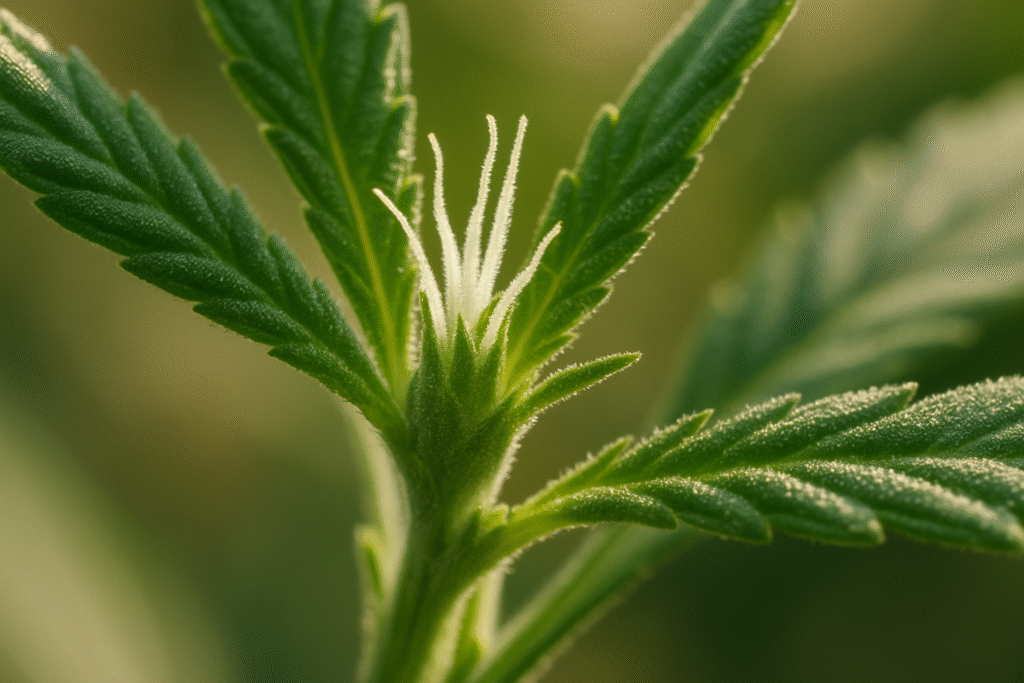
Feminized Seeds vs. Natural Growth
It’s true that feminized cannabis seeds are designed to produce only female plants. But even then, it’s wise to check each plant during its early stage of growth. Occasionally, stress or genetics can lead to hermaphrodite weed plants—those that develop both male and female traits. And if you’re growing from regular cannabis seeds, identifying the sex early is absolutely essential.
By the end of this post, you’ll know how to:
- Tell when cannabis plants begin to show gender differences.
- Spot female pre-flowers like white pistils and early calyx formation.
- Avoid common cannabis sexing mistakes (like misreading stipules).
- Use simple tools to help identify plant sex early.
- Handle males or hermaphrodites if they show up unexpectedly.
Ready to become a pro at spotting female marijuana plants before they flower? Let’s dive in.
🌼 Why It’s Crucial to Identify Female Cannabis Plants Early
If you’ve invested time, money, and care into growing weed, the last thing you want is to find out too late that you’ve got a male cannabis plant quietly lurking in your grow room. Early identification of female cannabis plants is absolutely crucial—especially if you’re aiming for high-quality, seedless buds.
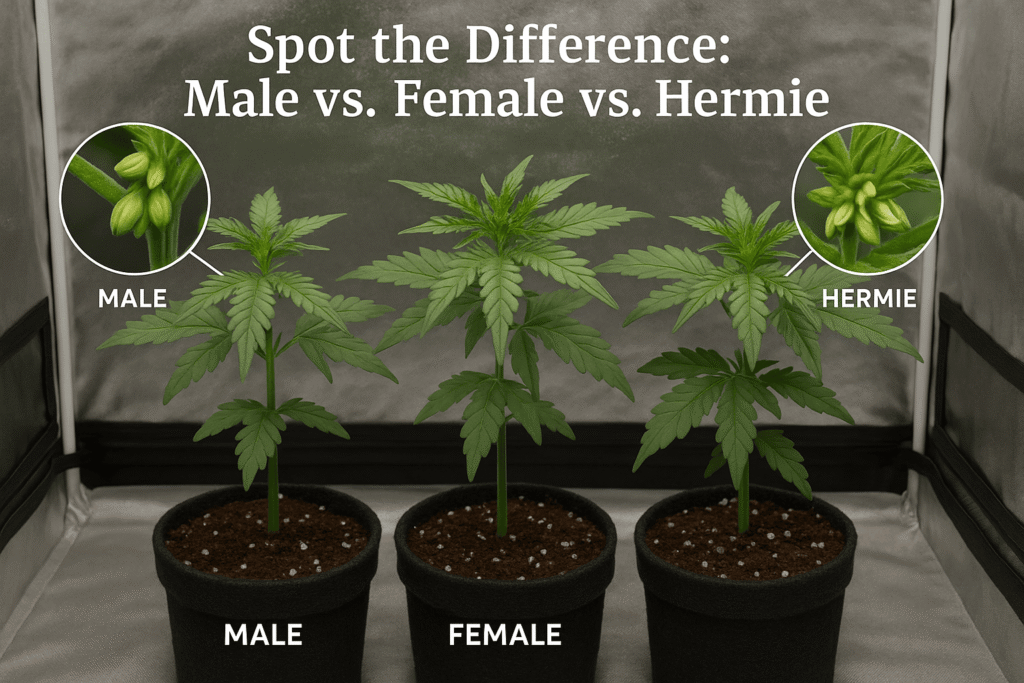
Let’s break down exactly why this matters:
Male Plants Can Pollinate Females and Ruin a Crop
The most obvious reason for early plant sexing is to protect your females. Male weed plants develop pollen sacs, which burst open and release pollen into the air. If you’re growing in a closed environment like a grow tent, that pollen can quickly spread and pollinate your female cannabis plants, causing them to grow seeds instead of producing potent flowers.
Once pollination happens, there’s no going back—the energy that would’ve gone into trichome-rich buds gets diverted into seed production. That means lower THC levels, harsher smoke, and ultimately, a disappointing harvest.
Better Yields with Seedless Buds (Sinsemilla)
Identifying female cannabis pre-flowers early ensures you’re cultivating sinsemilla—a Spanish term meaning “without seeds.” These buds are more potent, resinous, and flavorful because the plant focuses entirely on flower production.
If you’re aiming for top-shelf quality, removing male plants before the flowering stage is essential. Early identification boosts yield quantity and quality, helping you get the most from your grow.
Efficiency for Indoor and Outdoor Grows
In both indoor and outdoor setups, space and resources are limited. Water, nutrients, lighting, and grow media should all be reserved for plants that will actually produce smokeable weed. If you waste weeks nurturing a male, you’ve essentially lost valuable real estate in your grow area.
By sexing cannabis plants during the vegetative growth phase, you streamline your operation—eliminating the duds and focusing on the females that matter.
Essential for Growers Using Regular Seeds
While feminized seeds are bred to produce all-female plants, many growers still use regular cannabis seeds for genetic diversity, breeding, or budget reasons. In this case, early cannabis gender identification is 100% necessary. Roughly half of your plants may be male, and if you don’t catch them early, they could compromise your entire grow.
Even with feminized seeds, stress factors like light leaks or nutrient imbalances can lead to hermaphrodite plants, which also pose a pollination risk.
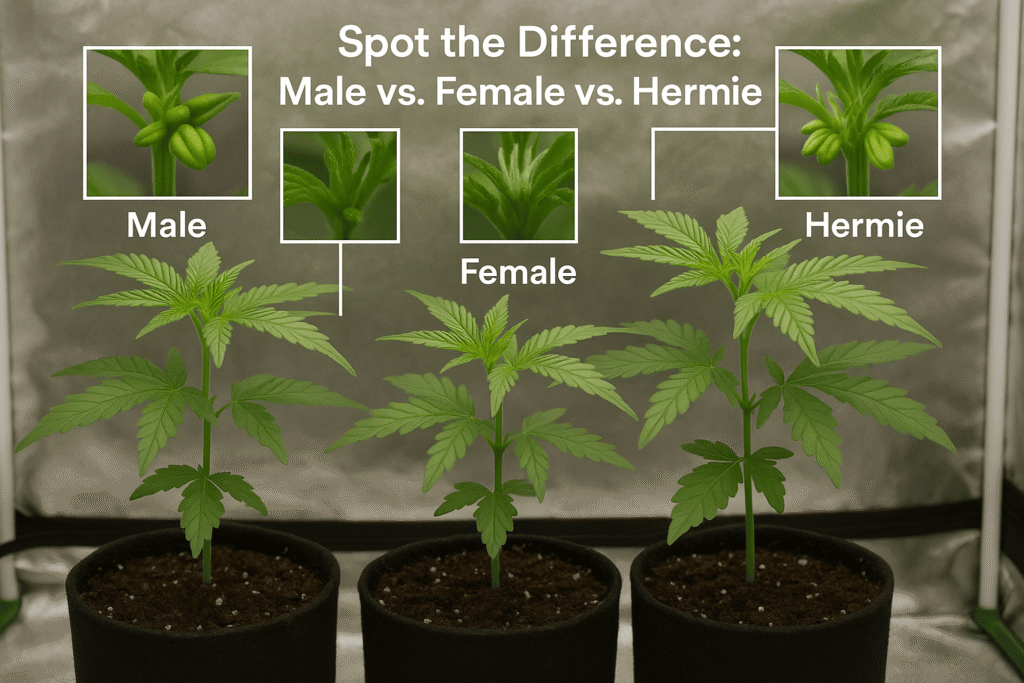
🌱 When Do Cannabis Plants Start Showing Gender?
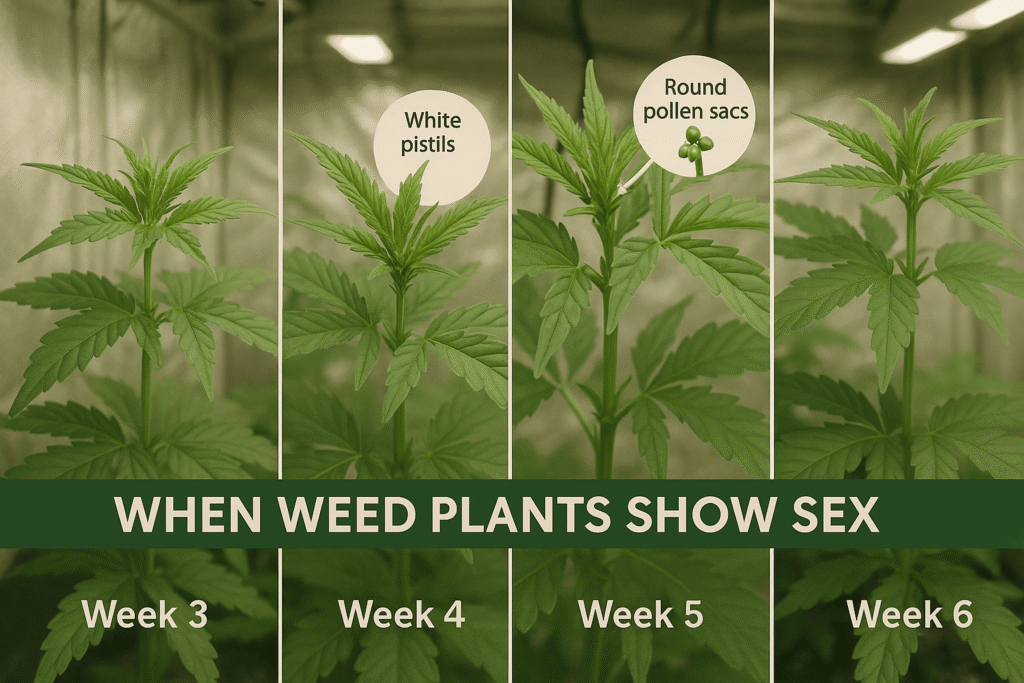
Knowing when cannabis plants begin to show their sex is key to planning your grow and preventing unwanted pollination. While it may feel like a waiting game, understanding the timeline and environmental triggers can help you spot pre-flowers before it’s too late.
Vegetative Stage Timeline (3–6 Weeks)
Most cannabis plants begin to reveal their gender between the 3rd and 6th week of the vegetative growth stage. This is when the plant has developed enough nodes—those V-shaped junctions where branches meet the stem—for pre-flowers to start forming.
- Female pre-flowers usually appear as tiny white hairs (pistils) emerging from a small calyx.
- Male pre-flowers, on the other hand, look like tiny balls or pollen sacs without hairs.
This early period of plant sexing is subtle, but if you’re paying close attention, you can start identifying gender before flowering even begins.
Environmental Factors That Influence Pre-Flower Development
Several conditions affect how soon your weed plants show sex, including:
- Light cycle: For photoperiod strains, a consistent 18/6 light schedule during the veg stage helps plants grow strong and reveal pre-flowers at the right time.
- Nutrient health: Healthy plants will show sex sooner. Overfeeding or underfeeding can stress plants and delay pre-flower formation.
- Temperature and humidity: Extreme heat or poor airflow can also impact cannabis plant development.
These factors are especially important in indoor grow setups, where you control most of the environment.
Autoflower vs. Photoperiod Considerations
- Autoflower cannabis strains typically begin showing their gender automatically by week 3–4, regardless of light cycle. These are great for beginners who don’t want to worry about flipping light schedules.
- Photoperiod cannabis strains won’t show clear sex signs until you manually switch the light cycle to 12/12 (12 hours of light and 12 hours of darkness), which simulates the approach of fall.
However, some photoperiod plants may “pre-sex” during veg, especially when they’re healthy and mature.
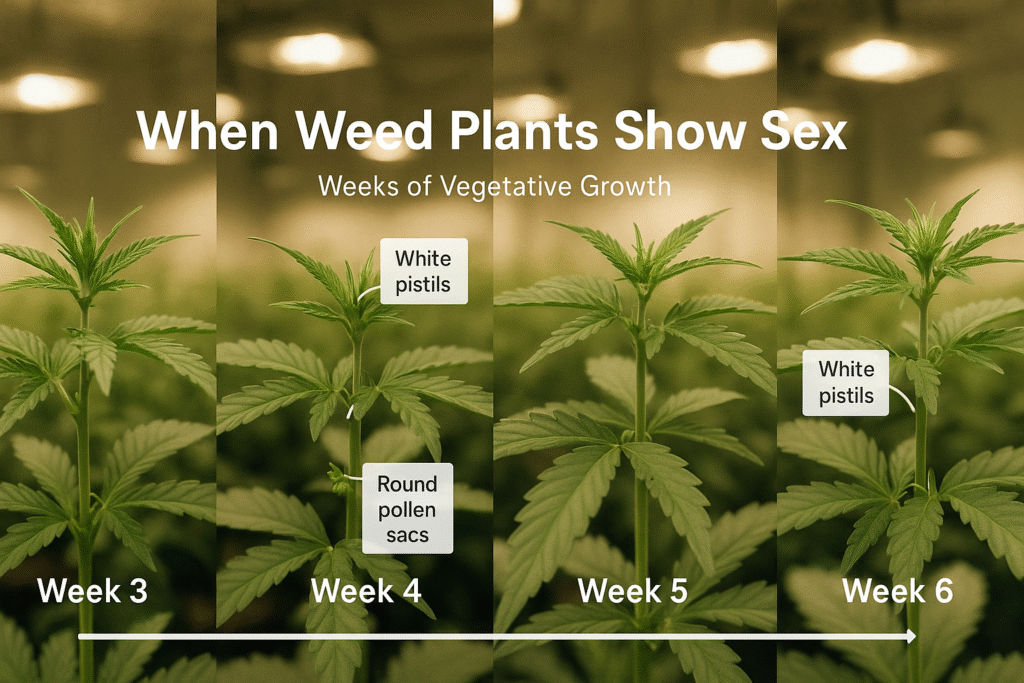
💡 Pro Tip: Don’t confuse stipules (small green leaf-like structures at nodes) with pre-flowers. Only pistils or pollen sacs indicate plant sex.
🌸 Early Visual Signs of Female Pot Plants
Spotting the early signs of a female cannabis plant can feel like finding a treasure—because it kind of is. If your goal is to harvest potent, resin-rich buds, you need to identify your female marijuana plants as early as possible, ideally before the flowering stage kicks in. Luckily, Mother Nature gives us some clues if we know where to look.

What to Look For: White Pistils, Calyxes, V-Shaped Hairs
The most reliable sign of a female cannabis plant in its early stage is the appearance of white, hair-like structures called pistils. These pistils grow out of a tiny teardrop-shaped base known as a calyx. You’ll typically find them emerging from the nodes—where branches meet the main stem.
Here’s what to spot:
- White pistils that are soft and wispy
- A small, oval-shaped calyx just beneath the pistils
- The pistils often appear in a V-shape, like two hairs forming a split
These traits indicate the start of female pre-flower development, and they’re your green light to continue nurturing that plant toward full bud production.
Where to Look: Plant Nodes and Branch Joints
Don’t waste time scanning every inch of the plant—focus your inspection at the nodes, which are the intersections where leaves and side branches grow out from the main stem. This is where pre-flowers first form.
Pro tip:
- Look at upper nodes first, especially if the plant is about 4–6 weeks old.
- Use a magnifying glass or phone macro lens to get a clearer look, especially in tight or leafy spots.
This is the best method for identifying female weed plants in early veg without damaging them or stressing the plant unnecessarily.
Close-Up Descriptions (and What Not to Confuse Them With)
A true female pre-flower will have:
- A single white pistil emerging from a teardrop-shaped calyx
- It may look fuzzy, delicate, or thread-like
- The shape is subtle but distinct compared to male pollen sacs
Watch out for these common false alarms:
- Stipules: Little green leaf-like flaps at the base of leaves—not a sign of gender
- New growth tips: Sometimes early leaves can look like pistils at first glance
If you’re ever unsure, don’t remove the plant immediately—give it a few more days and observe closely.
🚻 Female vs Male Pre-Flowers: What’s the Difference?
Identifying whether your cannabis plant is male or female in the pre-flowering stage can be tricky at first—but once you learn what to look for, it becomes second nature. Catching these differences early helps you avoid accidental pollination and focus your energy on growing female weed plants, the ones that actually produce smokable buds.
Let’s break it down.
🔬 1. Comparison Chart: Female Pistils vs. Male Pollen Sacs
Here’s a quick side-by-side overview of the key differences:
| Feature | Female Pre-Flower | Male Pre-Flower |
|---|---|---|
| Location | Appears at plant nodes | Appears at plant nodes |
| Shape | Teardrop-shaped calyx with one or two white pistils (hairs) | Small round ball-like structure (pollen sac) |
| Color | Pale green calyx with white pistils | Green, ball-shaped sac without hairs |
| Purpose | Grows into a bud that produces THC-rich flowers | Releases pollen to fertilize females |
| Timeline | Usually appears a few days later than males | Tends to appear slightly earlier |
This chart helps visually differentiate female and male cannabis in the pre-flower stage without having to guess.
🔍 2. Examples with Captions or Diagrams
Looking at actual plants—or high-quality macro photos—is one of the best ways to train your eye.
- Female pre-flowers look like a little green tear with tiny white hairs (pistils) sticking out.
- Male pre-flowers resemble a ball or cluster of balls, like little sacs hanging from the stem—no hairs present.
The pistils are key. If you see hairs, it’s almost certainly a female. If you see a round ball structure with no hairs, that’s a male.
Many growers keep a side-by-side reference image taped inside their grow tent for quick checks—especially helpful during your first few grows.
⚠️ 3. Visual Markers and Subtle Cues
Some extra tips for identifying pre-flower gender correctly:
- Female plants may take a couple more days to show their pre-flowers compared to males. So, don’t rush to judge before both have a chance to reveal themselves.
- Male pollen sacs can start clustering quickly. If you spot more than one at a node, it’s almost always a male.
- Hermaphrodites (plants with both male and female features) may show pistils and pollen sacs on the same plant. This is often caused by stress or unstable genetics.
Getting familiar with these visual markers can save your grow and maximize your yield.
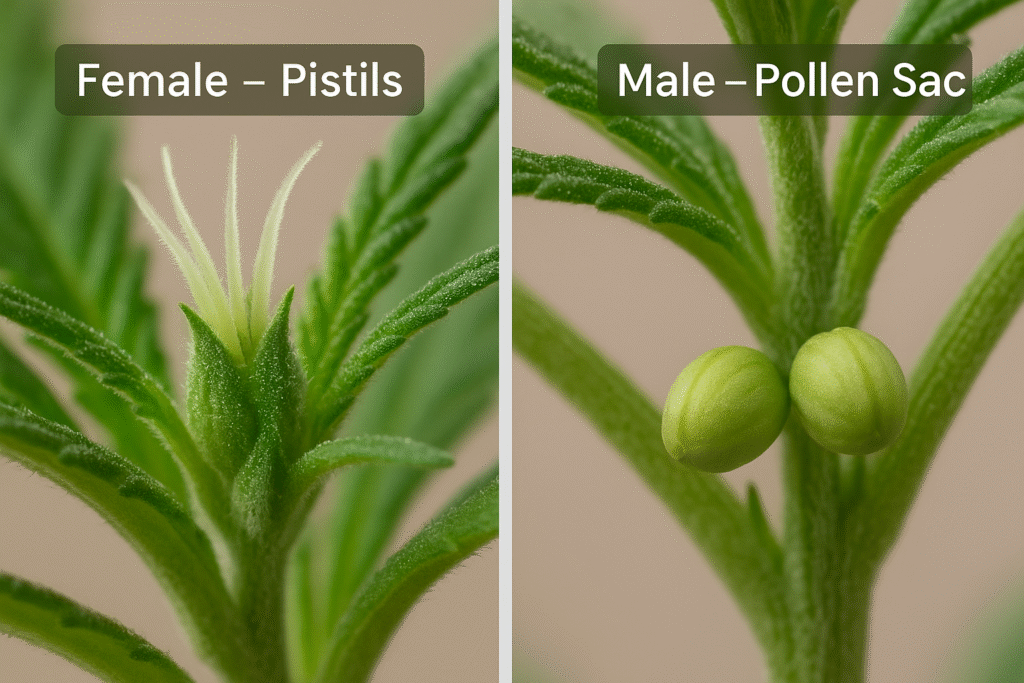
❌ Common Mistakes When Identifying Early Stage Plant Sex
Even experienced growers can make mistakes when trying to sex cannabis plants in the early stage. The pre-flower signs can be subtle, and misreading them can lead to keeping a male plant too long—or tossing out a female too early.
Let’s walk through the most common identification errors and how to avoid them so you can confidently manage your grow.
Mistaking Stipules or New Growth for Pre-Flowers
One of the most frequent beginner mistakes is confusing stipules—those small, green, leaf-like points at the base of a branch—for female pistils.
Let’s be clear:
- Stipules are not pistils. They are part of the plant’s normal growth at the node and are present on both male and female cannabis plants.
- True pre-flowers emerge slightly above the stipules and contain either a white pistil (female) or a round sac (male).
Another false alarm is new growth tips, which can look wispy or fuzzy at a glance. Don’t let early leaf development fool you.
Misidentifying Hermaphrodite (Intersex) Cannabis Plants
Some plants display both male and female characteristics—a condition known as being hermaphrodite or “hermie.” These intersex weed plants often form due to:
- Light stress (like interrupted dark periods)
- Genetics
- Over/underwatering
- Extreme environmental changes
A hermaphrodite plant may show pistils and small pollen sacs on the same node or on different branches. Many growers miss these mixed signals and accidentally leave hermies in the grow room, resulting in pollination of other females.
If you spot both pistils and sacs, it’s best to remove or isolate the plant immediately.
Assuming All Feminized Seeds Will Produce 100% Female Plants
Feminized seeds are specifically bred to grow female cannabis plants, but that doesn’t mean you’re totally in the clear. Under high stress (light leaks, bad nutrient schedules, extreme temps), even feminized marijuana seeds can produce a hermaphrodite or in rare cases, a rogue male.
So, always inspect your plants—even if they’re from feminized seeds.
Best practice:
- Keep a close eye on pre-flowers during weeks 3–6
- Don’t skip inspections just because of seed labels
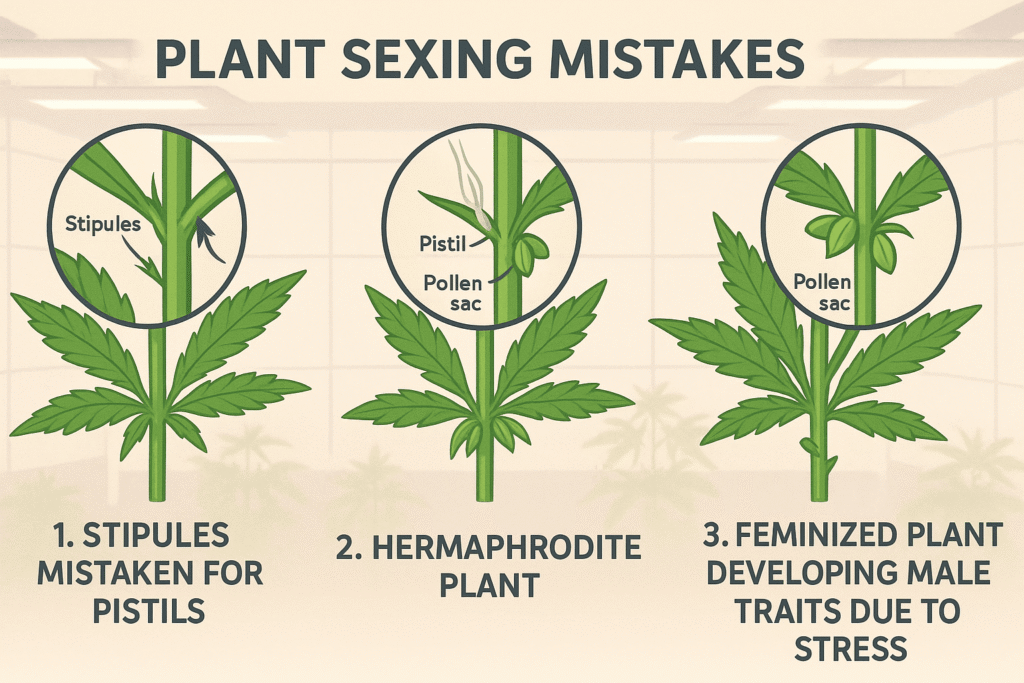
🧪 Tools and Techniques for Accurate Early Identification
Catching the sex of a cannabis plant early can make a huge difference in your grow’s success. But sometimes, the pre-flowers are so tiny, it’s hard to know what you’re really looking at—especially if you’re growing under bright lights or working with leafy genetics.
That’s where a few basic tools and good techniques come in. You don’t need to invest in high-tech gear—just a few smart, inexpensive additions to your grow kit will do the job.
🔍 1. Using Magnifying Glasses, Macro Lenses, or Jeweler’s Loupe
Pre-flowers are small—like really small. Especially in early veg, it can be tough to distinguish a female calyx with pistils from a male pollen sac with the naked eye.
Here’s what helps:
- A jeweler’s loupe (30x–60x) gives you the right zoom to clearly spot tiny pistils or sacs
- A clip-on phone macro lens is great for snapping close-up photos you can zoom in later
- A handheld magnifying glass works fine too, especially under good lighting
These tools are incredibly useful for confirming the gender of cannabis plants before mistakes happen.
💡 2. Ideal Lighting and Time of Day for Inspection
Lighting matters—a lot. If your grow area is too bright or too dark, you’ll have a harder time seeing tiny details.
Here’s how to get it right:
- Inspect your plants during their light cycle, ideally in the middle of their “day” period
- Use a soft white LED light or natural daylight if possible
- Avoid harsh shadows or direct grow lights that can hide detail
You can even take a cutting or branch tip to a brighter area if you need to inspect it more closely. Don’t rush—plant sexing accuracy depends on what you can clearly see.
🌿 3. Indoor vs Outdoor Challenges
If you’re growing cannabis outdoors, you’ll be relying more on natural light—which can help or hurt your inspection depending on the time of day.
Challenges for outdoor grows:
- Wind can make it hard to focus on the node
- Natural shadows can create false impressions
- You’ll need to time your inspection around full sun or soft morning light for best visibility
Indoor growers may have more control, but outdoor growers can still use portable magnifiers or even smartphone zoom with a steady hand.
In both cases, your eyes, your tools, and your patience are what make the difference between keeping a productive female or accidentally letting a male or hermaphrodite slip through.

🧹 Bonus: What to Do If You Find a Male or Hermie Plant
So you’ve checked your pre-flowers and… uh-oh. One of your plants has pollen sacs, or maybe even both pollen sacs and pistils on the same plant. Don’t panic—this happens to every grower at some point.
Whether you’ve discovered a male cannabis plant or a hermaphrodite (hermie), here’s exactly what to do next to protect your grow and salvage your harvest.
🛑 1. Immediate Removal and Isolation
If you identify a true male weed plant or a hermaphrodite cannabis plant, the best move is to act immediately. These plants can release pollen fast—especially in warm, well-lit environments.
Here’s what to do:
- Remove the plant from your grow space as soon as you’re certain
- If possible, bag the plant before moving it to avoid pollen shaking off into the air
- Clean the surrounding area gently to avoid pollen spread to neighboring females
Timing matters. Pollen sacs can mature and burst quickly, so hesitation can cost you your entire crop’s potency.
♻️ 2. How to Reuse the Soil
The good news is: just because a plant turned out male doesn’t mean everything it touched is ruined.
You can usually reuse the soil if:
- The plant didn’t develop mold or pests
- You didn’t let the male flower and drop pollen for long
- You refresh the soil with organic amendments before replanting
Simply remove the root ball, fluff the soil, and consider adding compost or microbial boosters before reusing it for new female cannabis seeds.
🌱 3. When to Consider Cloning Female Plants
If your grow space has room, and you’ve already identified healthy female cannabis plants, consider taking clones before they enter full flowering.
Why clone?
- Cloning a female ensures 100% genetic replication, including the same sex
- It saves money on seeds and guarantees the traits you like (aroma, potency, structure)
- It helps replace the space lost to a removed male
Cloning is a great fallback option if you just had to remove a few plants due to sexing errors or hermaphrodite issues.
🌸 Do All Feminized Seeds Produce Female Plants?
Almost always—but not 100%.
Feminized cannabis seeds are designed to eliminate male chromosomes and reliably produce female weed plants, but stressors like:
- Light leaks during dark cycles
- Overfeeding or underfeeding
- Heat stress or pH imbalance
can lead to a hermaphrodite weed plant (showing both male and female traits).
That’s why even with feminized seeds, you should always check for pre-flowers during weeks 3–6 to make sure each plant is developing normally.
👀 What If Pre-Flowers Aren’t Visible Yet?
If you’re in week 3–5 and still not seeing pistils or pollen sacs, don’t stress—some strains take a little longer to show sex, especially:
- Photoperiod strains that haven’t been switched to a 12/12 light cycle yet
- Sativas, which tend to grow taller before showing gender
- Plants that have been under environmental stress
What you can do:
- Be patient—check daily with a magnifying tool
- Make sure your plant is getting enough light and nutrients
- Wait until it develops more nodes, as sex is revealed at mature growth points
❓ FAQs
No, you can’t tell the sex of a cannabis plant just by looking at the seed.
Regular seeds have a 50/50 chance of being male or female.
Feminized seeds are bred to become female plants, but even then, there’s no visible difference in the seed itself.
Only genetic testing or actually growing the plant out will confirm its sex.
So, if someone tells you they can “eyeball” female seeds—take that with a grain of salt.
Yes—two main ways:
Use autoflower seeds, which often show sex by week 3 automatically
Flip photoperiod plants to 12/12 lighting early if you’re impatient and don’t mind sacrificing some veg time
However, be cautious: flipping lights too early can lead to smaller plants and reduced yield.
✅ Conclusion: Know What You’re Growing
Timing is everything. Most cannabis plants begin showing pre-flowers between weeks 3–6 of the vegetative stage, depending on whether you’re growing autoflower or photoperiod strains. Keeping a close eye on your plants during this window is key to catching sex indicators early.
Female cannabis plants show white pistils emerging from a small calyx at the plant’s nodes. These early signs often appear as V-shaped hairs and are the first visual markers that you’ve got a bud-producing plant on your hands.
It’s easy to confuse stipules or new growth with pistils. And hermaphrodites can trick even experienced growers. Always take your time and use tools like a magnifier to confirm what you’re seeing. Better visibility leads to better accuracy. A jeweler’s loupe, macro lens, and clean lighting can make all the difference when trying to identify plant sex. Indoors or outdoors, it’s worth investing in basic inspection tools.
If you find a male or intersex plant, remove it quickly to protect your females from pollination. Don’t waste nutrients, space, and energy on plants that won’t produce usable buds. Consider cloning your best females to make the most of your grow.
Early sexing is especially important when growing weed outside, where a single unnoticed male can pollinate nearby female plants and ruin your harvest. Make sure to read our complete guide on growing weed outdoors, where we cover everything from choosing the right spot to protecting your plants from pests and climate stress.
🌿 Want to take your grow to the next level?
Now that you know how to identify female pot plants early, it’s time to master the full cannabis life cycle. Check out our complete guide to cannabis growth stages to learn what happens from seedling to harvest—and how to support your plants at every phase. Or, if you’d like to multiply your favorite female genetics, read our step-by-step tutorial on how to clone marijuana plants the right way.




